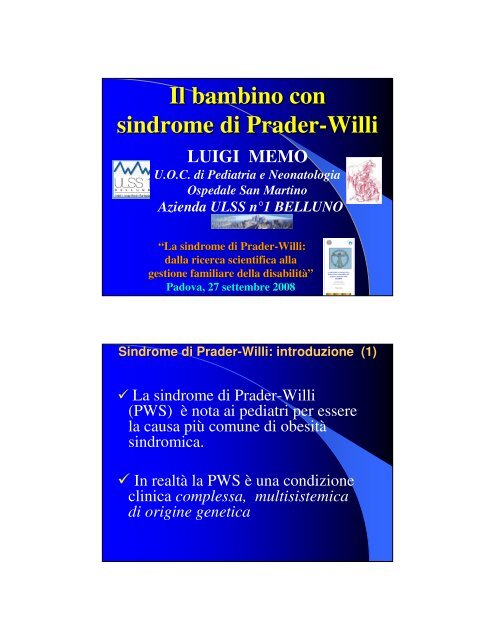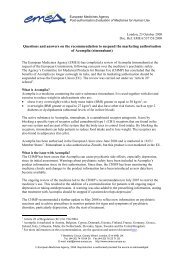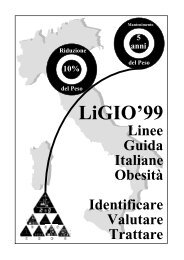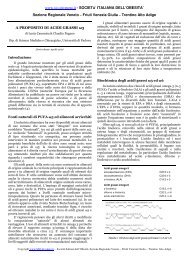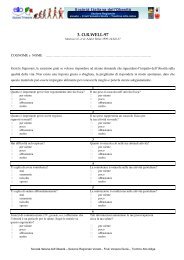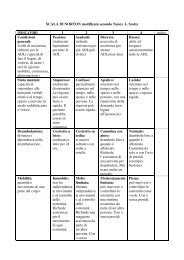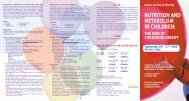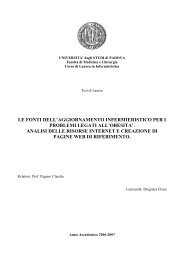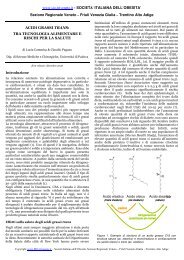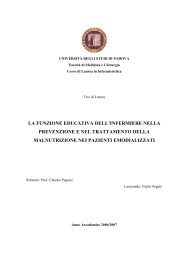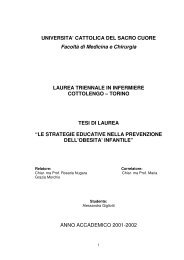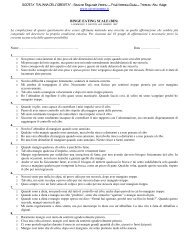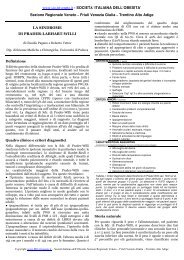Il bambino con sindrome di Prader-Willi - Societa' Italiana Obesità ...
Il bambino con sindrome di Prader-Willi - Societa' Italiana Obesità ...
Il bambino con sindrome di Prader-Willi - Societa' Italiana Obesità ...
You also want an ePaper? Increase the reach of your titles
YUMPU automatically turns print PDFs into web optimized ePapers that Google loves.
<strong>Il</strong> <strong>bambino</strong> <strong>con</strong><br />
<strong>sindrome</strong> <strong>di</strong> <strong>Prader</strong>-<strong>Willi</strong><br />
<strong>Prader</strong> <strong>Willi</strong><br />
LUIGI MEMO<br />
U.O.C. <strong>di</strong> Pe<strong>di</strong>atria e Neonatologia<br />
Ospedale San Martino<br />
Azienda ULSS n°1 BELLUNO<br />
“La <strong>sindrome</strong> <strong>di</strong> <strong>Prader</strong>-<strong>Willi</strong><br />
<strong>Prader</strong> <strong>Willi</strong>: :<br />
dalla ricerca scientifica alla<br />
gestione familiare della <strong>di</strong>sabilità”<br />
Padova, 27 settembre 2008<br />
Sindrome <strong>di</strong> <strong>Prader</strong>-<strong>Willi</strong><br />
<strong>Prader</strong> <strong>Willi</strong>: : introduzione (1)<br />
La <strong>sindrome</strong> <strong>di</strong> <strong>Prader</strong>-<strong>Willi</strong><br />
(PWS) è nota ai pe<strong>di</strong>atri per essere<br />
la causa più comune <strong>di</strong> obesità<br />
sindromica.<br />
In realtà la PWS è una <strong>con</strong><strong>di</strong>zione<br />
clinica complessa, multisistemica<br />
<strong>di</strong> origine genetica
Sindrome <strong>di</strong> <strong>Prader</strong>-<strong>Willi</strong><br />
<strong>Prader</strong> <strong>Willi</strong>: : introduzione (2)<br />
SEGNI CLINICI<br />
Ipotonia centrale prenatale e neonatale<br />
<strong>di</strong>fficoltà a succhiare<br />
scarso accrescimento<br />
Facies peculiare<br />
<strong>Obesità</strong> ad esor<strong>di</strong>o infantile<br />
Bassa statura<br />
Ipogona<strong>di</strong>smo ipotalamico<br />
genitali ipoplasici<br />
insufficienza puberale<br />
Fenotipo comportamentale peculiare<br />
Sindrome <strong>di</strong> <strong>Prader</strong>-<strong>Willi</strong><br />
<strong>Prader</strong> <strong>Willi</strong>: : introduzione (3)<br />
Juan Carrero de Miranda nel<br />
1680 ci fornisce probabilmente<br />
la prima fonte i<strong>con</strong>ografica.<br />
J. Down descrive il primo caso<br />
nel 1887<br />
Si deve a Andrea <strong>Prader</strong>,<br />
A.Labhart e H. <strong>Willi</strong>, pe<strong>di</strong>atri a<br />
Zurigo, la definitiva<br />
caratterizzazione, nel 1956.
Sindrome <strong>di</strong> <strong>Prader</strong>-<strong>Willi</strong><br />
<strong>Prader</strong> <strong>Willi</strong>: : introduzione (4)<br />
microdelezione (Ledbetter et<br />
al., 1981)<br />
<strong>di</strong>fetto dell’imprinting<br />
<strong>di</strong>somia uniparentale<br />
(Nicholls et al., 1989)<br />
eterogeneità genetica<br />
(Dickens et al., 1992)<br />
Sindrome <strong>di</strong> <strong>Prader</strong>-<strong>Willi</strong><br />
<strong>Prader</strong> <strong>Willi</strong>: : introduzione (5)<br />
Finally PWS is an excellent<br />
example of a genetic <strong>di</strong>sorder that<br />
is “treatable” as shown by the<br />
markedly improved outcomes in<br />
affected in<strong>di</strong>viduals who receive<br />
early <strong>di</strong>agnosis and appropriate<br />
therapy
Sindrome <strong>di</strong> <strong>Prader</strong>-<strong>Willi</strong><br />
<strong>Prader</strong> <strong>Willi</strong>: : introduzione (6)<br />
La PWS colpisce in eguale misura<br />
entrambi i sessi, <strong>con</strong> un’incidenza <strong>di</strong><br />
circa 1:10.000- 1.25.000 nati.<br />
La sua reale prevalenza è comunque<br />
sottostimata a causa della scarsa<br />
<strong>con</strong>oscenza della malattia.<br />
(Smith et al. Arch Dis Child. 2003,88:263-264)<br />
The detection of<br />
<strong>con</strong>genital abnormalities<br />
begins with the first<br />
examination<br />
after the delivery.<br />
Kessel J & Ward RM, Clinics in Perinatology,1998<br />
Perinatology,1998
Criteri <strong>di</strong>agnostici in epoca neonatale*<br />
Criteri maggiori (1 punto)<br />
– ipotonia centrale<br />
– <strong>di</strong>fficoltà all’alimentazione<br />
– tratti somatici caratteristici<br />
– ipoplasia genitale<br />
– anomalie citogenetico-molecolari <strong>di</strong> 15q11-q13<br />
Criteri minori (0.5 punti)<br />
– ridotti movimenti fetali o letargia neonatale o pianto debole<br />
– mani e/o pie<strong>di</strong> piccoli per l’età staturale<br />
– saliva densa e vischiosa<br />
* almeno 5 punti <strong>di</strong> cui almeno 4 criteri maggiori<br />
(Holm et al., Pe<strong>di</strong>atrics 1993; 91: 398-402)<br />
Quadro clinico neonatale della<br />
Sindrome <strong>di</strong> <strong>Prader</strong>-<strong>Willi</strong> <strong>Prader</strong> <strong>Willi</strong><br />
Nonostante la <strong>di</strong>sponibilità <strong>di</strong> criteri<br />
<strong>di</strong>agnostici e clinici, la <strong>di</strong>agnosi <strong>di</strong><br />
PWS avviene raramente nei primi<br />
mesi <strong>di</strong> vita, anche perché il<br />
fenotipo del neonato è sfumato e<br />
comunque <strong>di</strong>fferisce in maniera<br />
<strong>con</strong>siderevole<br />
rispetto alle età successive.
Strumenti del neonatologo <strong>di</strong> fronte ad<br />
un neonato <strong>con</strong> sospetta <strong>sindrome</strong> malfomativa<br />
ANAMNESI MIRATA<br />
ESAME OBIETTIVO ATTENTO DI<br />
TUTTI I SETTORI CORPOREI<br />
CONFRONTO CONFRONTO CON CON SPECIALISTI<br />
SPECIALISTI<br />
ED ED ED ESPERTI ESPERTI DEL DEL DEL SINGOLO<br />
SINGOLO<br />
SETTORE SETTORE<br />
SETTORE<br />
SISTEMI SISTEMI COMPUTERIZZATI<br />
COMPUTERIZZATI<br />
(POSSUM, (POSSUM, OMD) OMD)<br />
OMD)<br />
INTERNET INTERNET (LINK (LINK SPECIFICI!)<br />
SPECIFICI!)<br />
FOLLOW FOLLOW-UP<br />
FOLLOW UP UP<br />
Are there any in<strong>di</strong>viduals in the family with a<br />
similar type of problem?<br />
The vast majority of affected<br />
in<strong>di</strong>viduals are the only affected<br />
in<strong>di</strong>viduals in their family
Anamnesi peri/neonatale<br />
inizio e tipo dell’attività fetale<br />
età gestazionale<br />
modalità del parto<br />
parametri auxometrici<br />
alla nascita<br />
adattamento neonatale<br />
The physical examination should be complete, complete,<br />
with the physician searching for minor as well<br />
as major anomalies. anomalies<br />
When possible, possible,<br />
measurement should be taken<br />
to determine whether a given feature is truly<br />
abnormal. abnormal<br />
An unusual feature ideally should<br />
be interpreted in relation to the<br />
fin<strong>di</strong>ngs in other family members<br />
before its revelance is determined. determined.<br />
(Jones,1989)
Dati rilevanti dell’esame obiettivo<br />
nel neonato <strong>con</strong> PSW (1)<br />
Dolicocefalia<br />
Occhi “a mandorla”<br />
Upslanting rime palpebrali<br />
Guance paffute<br />
Bocca piccola<br />
Angoli della bocca rivolti in giù<br />
Labbro superiore sottile<br />
Dati rilevanti dell’esame obiettivo<br />
nel neonato <strong>con</strong> PSW (2)<br />
Mani e pie<strong>di</strong> piccoli<br />
Anomalie dei genitali<br />
Ipotonia<br />
pianto flebile<br />
ridotta attività mimica<br />
<strong>di</strong>fficoltà <strong>di</strong> alimentazione
Quadro clinico neonatale della PWS<br />
Stu<strong>di</strong>o Collaborativo<br />
GdS Genetica Clinica della SIN:<br />
41 neonati<br />
Treviso (Memo, Grazian)<br />
Palermo (Corsello, Giuffrè, Piccione)<br />
Pisa (Ghirri)<br />
Bologna (Cocchi, Capelli)<br />
Parma (Magnani)<br />
Reggio Emilia (Garavelli, Dona<strong>di</strong>o, Magnani)<br />
Milano (Selicorni, Milani, Clerici)<br />
Stu<strong>di</strong>o Collaborativo<br />
GdS Genetica Clinica della SIN<br />
25 M (61%); 16 F (39%)<br />
età me<strong>di</strong>a madre 32,5 aa<br />
età me<strong>di</strong>a padre 35 aa<br />
riduzione dei movimenti fetali 34,2 %<br />
peso alla nascita ≤10°C 75 %<br />
Apgar 1’ ≤ 4 12,2 %<br />
Apgar 1’ ≤ 7 56 %<br />
Hood O 2<br />
39 %
Stu<strong>di</strong>o Collaborativo<br />
GdS Genetica Clinica della SIN<br />
ipotonia 98%<br />
<strong>di</strong>fficoltà <strong>di</strong> alimentazione 93%<br />
pianto flebile 80%<br />
ipogona<strong>di</strong>smo 73%<br />
facies ipomimica 63%<br />
labbro superiore sottile 63%<br />
guance paffute 61%<br />
occhi a mandorla 59%<br />
bocca piccola 54%<br />
upslanting rime palpebrali 46%<br />
mani e pie<strong>di</strong> piccoli 46%<br />
dolicocefalia 34%<br />
<strong>di</strong>ta affusolate 29%<br />
micrognazia 20%<br />
PWS: CRITERI DIAGNOSTICI<br />
Criteri maggiori (1 punto)<br />
ipotonia centrale nei primi mesi <strong>di</strong> vita<br />
<strong>di</strong>fficoltà all’alimentazione e scarsa crescita nei primi 6<br />
mesi<br />
rapida crescita <strong>di</strong> peso fra 1 e 6 anni (iperfagia)<br />
tratti somatici caratteristici<br />
ipogona<strong>di</strong>smo<br />
ritardo dello sviluppo psichico
PWS: CRITERI DIAGNOSTICI<br />
Criteri minori (0.5 punti)<br />
ridotti movimenti fetali o letargia neonatale<br />
bassa statura a 15 anni<br />
mani e/o pie<strong>di</strong> piccoli per l’età staturale<br />
saliva densa e vischiosa<br />
esotropia/miopia<br />
<strong>di</strong>sturbi del linguaggio<br />
alterazioni del comportamento<br />
<strong>di</strong>sturbi del sonno<br />
escoriazioni cutanee autoprovocate<br />
ipopigmentazione<br />
PWS: CRITERI DI SUPPORTO<br />
elevata soglia del dolore<br />
<strong>di</strong>minuito riflesso del vomito<br />
alterazioni della termoregolazione nella 1a infanzia o<br />
alterata sensibilità alla temperatura nella 2a infanzia<br />
scoliosi e/o cifosi<br />
adrenarca precoce<br />
osteoporosi<br />
abilità nei giochi <strong>di</strong> pazienza (puzzle)<br />
normali indagini neuromuscolari<br />
reazioni allergiche ad alcuni farmaci<br />
intossicazione da acqua<br />
gravi malattie gastriche
DIAGNOSI DIFFERENZIALE<br />
sindromi associate ad ipotonia neonatale<br />
Malattie neuromuscolari<br />
sindromi associate a ritardo mentale e<br />
obesità<br />
<strong>sindrome</strong> <strong>di</strong> Bardet-Biedl<br />
<strong>sindrome</strong> <strong>di</strong> Borjeson-Forssman-Lehman<br />
<strong>sindrome</strong> <strong>di</strong> Cohen<br />
Osteo<strong>di</strong>strofia ere<strong>di</strong>taria <strong>di</strong>Albright<br />
Diagnosi <strong>di</strong>fferenziale nel floppy infant<br />
A: <strong>di</strong> origine periferica:<br />
Miopatie <strong>con</strong>genite strutturate<br />
Miopatie metaboliche<br />
Distrofie muscolari <strong>con</strong>genite<br />
Distrofia miotonica <strong>con</strong>genita<br />
Werdnig Hoffmann<br />
Miastenia neonatale<br />
B:<strong>di</strong> origine centrale:<br />
patologie perinatali<br />
anomalie cromosomiche<br />
malformazioni cerebrali ed encefalopatie degenerative<br />
patologia metabolica <strong>con</strong>genita<br />
anomalie endocrine<br />
C: ipotonia <strong>con</strong>genita benigna
DIAGNOSI DIFFERENZIALE<br />
sindromi associate ad ipotonia neonatale<br />
Malattie neuromuscolari<br />
sindromi associate a ritardo mentale e<br />
obesità<br />
<strong>sindrome</strong> <strong>di</strong> Bardet-Biedl<br />
<strong>sindrome</strong> <strong>di</strong> Borjeson-Forssman-Lehman<br />
<strong>sindrome</strong> <strong>di</strong> Cohen<br />
Osteo<strong>di</strong>strofia ere<strong>di</strong>taria <strong>di</strong>Albright<br />
Bardet-Biedl syndrome<br />
# 209900 (OMIM) Autosomal recessive inheritance<br />
GROWTH : Obesity<br />
HEAD AND NECK :<br />
Rod-<strong>con</strong>e dystrophy, onset be end of 2nd decade,<br />
Retinitis pigmentosa , Strabismus ,Cataracts<br />
High arched palate, Dental crow<strong>di</strong>ng , Hypodontia ,<br />
Small tooth roots<br />
CARDIOVASCULAR: Left ventricular<br />
hypertrophy, Congenital heart defects, Hypertension<br />
ABDOMEN: Hepatic fibrosis , Hirschsprung<br />
<strong>di</strong>sease<br />
GENITOURINARY: Hypogona<strong>di</strong>sm, Renal<br />
anomalies, Nephrogenic <strong>di</strong>abetes insipidus<br />
SKELETAL: Polydactyly ,Brachydactyly<br />
NEUROLOGIC: Speech <strong>di</strong>sorder ,Speech<br />
delay,Learning <strong>di</strong>sabilities,Developmental delay,<br />
Ataxia,Poor coor<strong>di</strong>nation
Borjeson-Forssman-Lehman syndrome<br />
# 301900 (OMIM) X linked recessive inheritance<br />
GROWTH : obesity , short stature<br />
HEAD AND NECK :<br />
microcephaly<br />
coarse facies, prominent supraorbital ridges, large ears<br />
deep-set eyes, nystagmus, ptosis, poor vision, narrow<br />
palpebral fissures<br />
GENITOURINARY: small penis, small, atrophic testes,<br />
gynecomastia ,delayed puberty<br />
SKELETAL:<br />
Thick calvarium<br />
narrow cervical spinal canal, mild scoliosis<br />
hypoplastic <strong>di</strong>stal and middle phalanges, soft, fleshy<br />
hands, tapering fingers, short toes<br />
NEUROLOGIC: severe mental retardation, hypotonia,<br />
abnormal EEG , seizures<br />
Cohen syndrome<br />
# 216550 (OMIM) Autosomal recessive inheritance<br />
GROWTH : truncal obesity, short stature<br />
HEAD AND NECK :<br />
microcephaly<br />
chorioretinal dystrophy, myopia<br />
prominent nasal bridge, open mouth appearance,<br />
prominent upper central incisors, maxillary<br />
hypoplasia, micrognathia<br />
CARDIOVASCULAR: mitral valve prolapse<br />
ENDOCRINE FEATURES : delayed puberty,<br />
growth hormone deficiency<br />
SKELETAL:mild lumbar lordosis and thoracic<br />
scoliosis, joint hyperextensibility, cubitus and genu<br />
valgus, narrow hands and feet, mild shortening of<br />
metacarpals and metatarsal<br />
NEUROLOGIC: mental retardation , hypotonia,<br />
seizures, delayed motor milestones, large corpus<br />
callosum<br />
HEMATOLOGY: leukopenia
DIAGNOSI DIFFERENZIALE<br />
sindromi <strong>con</strong> ritardo mentale e (talora) obesità<br />
<strong>sindrome</strong> dell’ X fragile<br />
<strong>sindrome</strong> <strong>di</strong> Down<br />
<strong>sindrome</strong> <strong>di</strong> Angelman<br />
<strong>sindrome</strong> <strong>di</strong> Rett<br />
numerose sindromi da<br />
anomalia cromosomica<br />
Patologia ipotalamica acquisita<br />
postraumatica<br />
tumori<br />
postoperatoria<br />
The daily work of a syndromologist is<br />
similar to the work of those who are<br />
engaged in criminology: both look for<br />
the tiniest hints and then <strong>con</strong>strunct<br />
an argument to reach a <strong>con</strong>clusion<br />
(<strong>di</strong>agnosis)<br />
(Aase, 1990)<br />
Formulare<br />
una o più<br />
ipotesi<br />
<strong>di</strong>agnostiche<br />
Esame obiettivo : presenza <strong>di</strong> ipotonia e<br />
lievi <strong>di</strong>smorfismi<br />
Routinario<br />
Analitico<br />
Approccio<br />
alla<br />
<strong>di</strong>agnosi<br />
specifica<br />
Gestaltico
• Metodo classico, tappe<br />
sequenziali<br />
• completezza e pertinenza dd<br />
• fruibile da meno esperti<br />
<strong>di</strong>agnosi<br />
routinaria<br />
• proce<strong>di</strong>mento laborioso, relativamente<br />
inefficiente, <strong>di</strong>spen<strong>di</strong>oso<br />
• pericolo <strong>di</strong> sopravvalutare o ignorare<br />
importanti informazioni (griglia <strong>di</strong><br />
domande e segni)<br />
Work up of the floppy infant<br />
Hypotonia<br />
Obtundation<br />
Seizures<br />
Hyperactive deep tendon reflexes<br />
Central<br />
hypotonia<br />
CT/MRI<br />
EEG<br />
Infection screen<br />
Birth Birth trauma<br />
trauma<br />
Hypoxic Hypoxic ischemic encephalopathy<br />
Sepsis<br />
Sepsis<br />
Cerebral Cerebral dysgenesis<br />
dysgenesis<br />
dysgenesis<br />
Floppy infant:<br />
History<br />
Physical examination<br />
Multi<strong>di</strong>sciplinary assessment<br />
(Genetics/Neurology/Metabolism):<br />
targeted investigations<br />
Karyotyping<br />
FISH<br />
Methilation stu<strong>di</strong>es<br />
Mutation analysis<br />
Chromosomal Chromosomal rearrengements<br />
<strong>Prader</strong> <strong>Prader</strong>-Willy<br />
<strong>Prader</strong> Willy Willy syndrome<br />
syndrome<br />
Congenital Congenital Myotonic Myotonic Dystrophy<br />
Subtelomeric<br />
Subtelomeric Subtelomeric deletions<br />
deletions<br />
Hypotonia<br />
Weakness<br />
Areflexia<br />
Fasciculations<br />
Arthrogryposis<br />
Disorders of<br />
the lower<br />
motor unit<br />
Creatine Kinase assay<br />
Electrophysiology<br />
EMG<br />
Nerve biopsy Muscle biopsy<br />
Direct mutation analysis<br />
Congenital Congenital Congenital Muscular Muscular<br />
Muscular<br />
Dystrophy Dystrophy<br />
Dystrophy<br />
Congenital Congenital Myopathies<br />
Myopathies<br />
Inherited Inherited neuropathies<br />
neuropathies
Ipotesi routinaria <strong>di</strong> PWS<br />
in epoca neonatale<br />
In presenza <strong>di</strong> un neonato o <strong>di</strong> un<br />
lattante ipotonico <strong>con</strong> suzione<br />
debole, specie se presenta i<br />
<strong>di</strong>smorfismi facciali sopra descritti<br />
ed ipogona<strong>di</strong>smo, va richiesta, nel<br />
sospetto <strong>di</strong> una PSW un test <strong>di</strong><br />
metilazione per PSW ed in caso <strong>di</strong><br />
positività una FISH specifica.<br />
(Gunay-Aygun et al., Pe<strong>di</strong>atrics 2001; 108: e92)<br />
<strong>Il</strong> “segno clinico che induce il sospetto”:<br />
ovvero l’ipotesi gestaltica<br />
• Rapido, abbrevia molti passaggi<br />
del modello classico<br />
• efficiente e pratico<br />
Ri<strong>con</strong>oscimento<br />
dei “pattern”:<br />
un’attività molto<br />
comune<br />
• complesso, meno formale<br />
• ri<strong>con</strong>oscimento basato<br />
sull’esperienza<br />
Ri<strong>con</strong>oscere l’autore <strong>di</strong> un quadro<br />
Ri<strong>con</strong>oscere un amico nella folla<br />
Ri<strong>con</strong>oscere il quadro clinico <strong>di</strong><br />
una malattia esantematica
The neonatal presentation<br />
of <strong>Prader</strong>-<strong>Willi</strong> <strong>Prader</strong> <strong>Willi</strong> syndrome revisited<br />
Miller et al., J Pe<strong>di</strong>atr 1999; 134: 226-228<br />
Neonatal hypotonia: hypotonia<br />
don’t don’ t forget the <strong>Prader</strong>-<strong>Willi</strong><br />
<strong>Prader</strong> <strong>Willi</strong> syndrome<br />
Trifirò et al., Acta Pae<strong>di</strong>atr 2003; 92: 1085-1089<br />
Genetic Obesity Study Group (SIEDP)<br />
Permette la<br />
<strong>di</strong>agnosi <strong>di</strong><br />
<strong>con</strong><strong>di</strong>zioni<br />
MOLTO rare<br />
Lista <strong>di</strong> segni più appropriati (maniglie <strong>di</strong>agnostiche): i migliori segni<br />
clinici sono i più rari e quelli ad insorgenza embrionale oiù precoce:<br />
A – B – C – D …..<br />
Gestalt<br />
L’ ipotesi analitica<br />
Sofware<br />
Proce<strong>di</strong>mento<br />
lungo<br />
ri<strong>con</strong>oscimento<br />
basato<br />
sull’esperienza<br />
Lista <strong>di</strong> <strong>di</strong>agnosi<br />
compatibili<br />
Gamut<br />
Libro
La <strong>con</strong>ferma della <strong>di</strong>agnosi<br />
La <strong>di</strong>agnosi <strong>di</strong> PWS è<br />
attualmente agevole.<br />
I criteri della Holm sono<br />
sufficienti ad esprimere un<br />
fondato sospetto clinico<br />
che poi il test <strong>di</strong><br />
metilazione può<br />
<strong>con</strong>fermare agevolmente.
TEST DIAGNOSTICI<br />
test <strong>di</strong> metilazione<br />
FISH<br />
microsatelliti<br />
Stu<strong>di</strong>o Collaborativo<br />
GdS Genetica Clinica della SIN<br />
delezione 60%<br />
traslocazione de novo 3%<br />
<strong>di</strong>somia uniparentale materna 34%<br />
mutazione del centro dell’imprinting 3%
DIAGNOSI CORRETTA<br />
Accurate <strong>di</strong>agnosis of a specific<br />
syndrome among the 0.7% of<br />
babies born with multiple<br />
malformations is a necessary<br />
prerequisite of provi<strong>di</strong>ng a<br />
prognosis and a plan of<br />
management for the affected<br />
infant, as well as genetic<br />
counseling for the parents.<br />
(K.L Jones, 1997)<br />
L’importanza della <strong>di</strong>agnosi in un<br />
neonato <strong>con</strong> <strong>sindrome</strong> <strong>di</strong> <strong>Prader</strong> <strong>Willi</strong> (1)<br />
Evitare nei piccoli pazienti inutili ed<br />
invasive indagini <strong>di</strong>agnostiche<br />
Fornire ai genitori informazioni sulla<br />
prognosi, nonché sul rischio <strong>di</strong> ricorrenza<br />
ed eventuale possibilità <strong>di</strong> <strong>di</strong>agnosi<br />
prenatale<br />
Fornire loro delle opzioni terapeutiche per<br />
la prevenzione ed il trattamento<br />
dell’obesità.
L’importanza della <strong>di</strong>agnosi in un<br />
neonato <strong>con</strong> <strong>sindrome</strong> <strong>di</strong> <strong>Prader</strong> <strong>Willi</strong> (2)<br />
Quale sarà il futuro del nostro<br />
<strong>bambino</strong>?<br />
Qual è stata la causa della<br />
<strong>sindrome</strong>?<br />
Che rischio <strong>di</strong> ricorrenza abbiamo<br />
in caso <strong>di</strong> futura gravidanza?<br />
Comunicazione = intervento me<strong>di</strong>co<br />
La comunicazione della <strong>di</strong>agnosi è un<br />
“intervento me<strong>di</strong>co” vero e proprio,<br />
che richiede <strong>con</strong>oscenze <strong>di</strong> base<br />
(sapere), acquisizione <strong>di</strong> specifici<br />
strumenti e <strong>di</strong> specifiche abilità<br />
(saper fare), un minimo <strong>di</strong> esperienza<br />
(saper essere).<br />
<strong>Il</strong> tutto attuato non solo dal me<strong>di</strong>co che ha il compito<br />
<strong>di</strong> parlare <strong>con</strong> i genitori, ma <strong>con</strong><strong>di</strong>viso da tutto il<br />
personale, compreso quello infermieristico
Chi gestisce la prima<br />
comunicazione <strong>di</strong> <strong>di</strong>agnosi deve<br />
tenere a mente che “il primo<br />
impatto non si scorda mai”<br />
la comunicazione costituisce un punto<br />
importante nel processo <strong>di</strong> accettazione del<br />
<strong>bambino</strong> da parte dei genitori<br />
<strong>Il</strong> neonato <strong>con</strong> PSW:<br />
comunicazione della <strong>di</strong>agnosi<br />
Mastroiacovo P, Memo L.<br />
Raccomandazioni per la comunicazione<br />
della <strong>di</strong>agnosi <strong>di</strong> malattia genetica<br />
complessa e/o <strong>di</strong> <strong>di</strong>sabilità <strong>con</strong>genita. ...<br />
www.sip.it/moduli/scientifico.<br />
www.onsp.it/Sindromologia.doc
<strong>Il</strong> neonato <strong>con</strong> PSW: dopo la<br />
comunicazione della <strong>di</strong>agnosi… (1)<br />
<strong>Il</strong> periodo imme<strong>di</strong>atamente successivo<br />
alla comunicazione della <strong>di</strong>agnosi deve<br />
essere gestito nell’ambito della struttura<br />
neonatologica <strong>con</strong> un lavoro <strong>di</strong> equipe<br />
(me<strong>di</strong>co, infermiera, terapista dello<br />
sviluppo) finalizzato a favorire<br />
l’elaborazione del lutto familiare<br />
attraverso <strong>di</strong>verse modalità <strong>di</strong> compenso.<br />
<strong>Il</strong> neonato <strong>con</strong> PSW: dopo la<br />
comunicazione della <strong>di</strong>agnosi… (2)<br />
I genitori devono essere accompagnati ad<br />
accettare la realtà attraverso un <strong>con</strong>tatto<br />
crescente <strong>con</strong> il proprio figlio;<br />
caratteristiche come l’ipotono e<br />
l’ipocinesia devono essere da loro<br />
valutate ed accettate <strong>con</strong> l’aiuto della<br />
fisioterapista che evidenzia i limiti e<br />
soprattutto le variazioni in positivo che<br />
possono essere colte nel tempo.
<strong>Il</strong> neonato <strong>con</strong> PSW: dopo la<br />
comunicazione della <strong>di</strong>agnosi… (3)<br />
La funzione <strong>di</strong> suzione deve essere<br />
sostenuta <strong>con</strong> tecniche che prevedano il<br />
<strong>di</strong>retto coinvolgimento della madre dalla<br />
fase iniziale della "sonda" a quella della<br />
suzione <strong>con</strong> biberon o ad<strong>di</strong>rittura al seno,<br />
utilizzando personale infermieristico<br />
sensibilizzato in tal senso.<br />
Dimissione “protetta” del neonato<br />
<strong>con</strong> PWS (1)<br />
<strong>con</strong>cordata <strong>con</strong> i genitori<br />
collaborazione-informazione<br />
<strong>con</strong> il pe<strong>di</strong>atra <strong>di</strong> famiglia<br />
certificato <strong>di</strong> esenzione<br />
certificazione <strong>di</strong> malattia rara<br />
programmazione del follow-up
Dimissione “protetta” del neonato<br />
<strong>con</strong> PWS (2)<br />
Prima delle <strong>di</strong>missioni dal reparto i<br />
genitori devono aver raggiunto una<br />
fase <strong>di</strong> sufficiente sicurezza "tecnica"<br />
ma soprattutto una fase <strong>di</strong> sufficiente<br />
compenso emotivo: non si <strong>di</strong>mette il<br />
<strong>bambino</strong> ma l’intero sistema-famiglia!<br />
Dimissione “protetta” del neonato <strong>con</strong> PWS (3)<br />
o supporto dello<br />
psicologo o del<br />
neuropsichiatra<br />
infantile<br />
o ruolo delle<br />
associazioni<br />
genitori<br />
o servizi pubblici<br />
territoriali<br />
o in<strong>di</strong>viduazione <strong>di</strong> un<br />
coor<strong>di</strong>natore delle<br />
attività assistenziali<br />
aiutare i genitori a<br />
comprendere in maniera<br />
realistica i problemi che il<br />
loro <strong>bambino</strong> presenta<br />
aiutare i genitori a mantenere<br />
e facilitare il <strong>con</strong>fronto<br />
all’interno della coppia<br />
aiutare i genitori a<br />
recuperare gradualmente le<br />
loro competenze <strong>di</strong> coping<br />
al fine <strong>di</strong> utilizzare le risorse<br />
in loro possesso e<br />
riorganizzarle
Dimissione “protetta” del neonato <strong>con</strong> PWS (4)<br />
o supporto dello<br />
psicologo o del<br />
neuropsichiatra<br />
infantile<br />
o ruolo delle<br />
associazioni genitori<br />
o servizi pubblici<br />
territoriali<br />
o in<strong>di</strong>viduazione <strong>di</strong> un<br />
coor<strong>di</strong>natore delle<br />
attività assistenziali<br />
www.praderwilli.it<br />
l’esistenza va<br />
segnalata, non imposta<br />
informazioni accurate<br />
sulla specifica<br />
<strong>con</strong><strong>di</strong>zione<br />
sostegno<br />
scambio <strong>di</strong> esperienze<br />
reciproco<br />
RISORSE<br />
<strong>Prader</strong>-<strong>Willi</strong> Syndrome Association<br />
www.pwsausa.org<br />
International <strong>Prader</strong>-<strong>Willi</strong> Syndrome Organisation<br />
www.ipswo.org
Dimissione “protetta” del neonato <strong>con</strong> PWS (5)<br />
o supporto dello<br />
psicologo o del<br />
neuropsichiatra<br />
infantile<br />
o ruolo delle<br />
associazioni genitori<br />
o servizi pubblici<br />
territoriali<br />
o in<strong>di</strong>viduazione <strong>di</strong> un<br />
coor<strong>di</strong>natore delle<br />
attività assistenziali<br />
del neuropsichiatra infantile<br />
o ruolo delle associazioni<br />
genitori<br />
o servizi pubblici territoriali<br />
o in<strong>di</strong>viduazione <strong>di</strong> un<br />
coor<strong>di</strong>natore delle attività<br />
assistenziali<br />
costituis<strong>con</strong>o la risposta<br />
alla presa in carico<br />
riabilitativa<br />
<strong>di</strong>minuis<strong>con</strong>o il <strong>di</strong>sagio<br />
degli spostamenti<br />
accompagnano nel tempo<br />
il <strong>bambino</strong><br />
rispondono ai <strong>di</strong>versi<br />
bisogni nell’arco della sua<br />
vita<br />
mantengono memoria dei<br />
suoi passi e della sua<br />
storia<br />
Dimissione “protetta” del neonato<br />
<strong>con</strong> PWS (6)<br />
o supporto dello psicologo o<br />
Who is the boss?<br />
Chi è il coor<strong>di</strong>natore<br />
dell’assistenza<br />
al bimbo <strong>con</strong> PWS?<br />
NEONATOLOGO<br />
PEDIATRA DI FAMIGLIA<br />
PEDIATRA DI COMUNITA’<br />
PEDIATRA GENETISTA<br />
GENETISTA MEDICO<br />
NEUROPSICHIATRA INFANTILE<br />
PSICOLOGO<br />
DIETISTA<br />
FISIATRA<br />
ASSISTENTE SOCIALE
“ Ci vuole un villaggio<br />
intero per allevare un<br />
<strong>bambino</strong>”<br />
Presa in carico del bimbo PSW<br />
Me<strong>di</strong>ci specialisti<br />
Fisioterapisti<br />
Pe<strong>di</strong>atra<br />
<strong>di</strong> famiglia<br />
Presi<strong>di</strong>o Ospedaliero:<br />
Genetista clinico<br />
famiglia<br />
Scuola<br />
Servizi<br />
territoriali
E DOPO LA DIAGNOSI …<br />
problemi auxologici<br />
problemi <strong>di</strong>etetici<br />
problemi neurologici<br />
problemi comportamentali<br />
problemi endocrinologici<br />
problemi muscoloscheletrici<br />
problemi oculistici<br />
problemi odontoiatrici<br />
problemi dermatologici<br />
Manifestations and management:<br />
growth and fee<strong>di</strong>ng<br />
failure to thrive<br />
infantile hypotonia causes great<br />
<strong>di</strong>fficulty with sucking<br />
breast fee<strong>di</strong>ng is rarely possible<br />
special fee<strong>di</strong>ng techniques (special<br />
nipples, gavage) may be necessary for<br />
weeks to months to assure adequate<br />
nutrition and avoid failure to thrive
Manifestations and management:<br />
growth and fee<strong>di</strong>ng<br />
Evaluation<br />
height and weight should be<br />
monitored frequently<br />
adequacy of caloric intake<br />
should be assessed<br />
the child should be<br />
assessed for possible<br />
hypothyroi<strong>di</strong>sm<br />
Manifestations and management:<br />
growth and fee<strong>di</strong>ng<br />
Treatment<br />
if a source of growth failure<br />
is identified, it should be treated<br />
by standard means and/or<br />
temporary measures (increasing<br />
caloric <strong>con</strong>centration of<br />
formula, gastrostomy tube<br />
fee<strong>di</strong>ngs,...)<br />
Supportive counseling for<br />
parents<br />
Thyroid hormone
Manifestations and management:<br />
growth and fee<strong>di</strong>ng<br />
short stature<br />
90% of people with PWS who have not<br />
been treated with GH will have short<br />
stature<br />
specific growth charts: average<br />
height is 155 cm for males and 148 cm<br />
for females<br />
Manifestations and management:<br />
growth and fee<strong>di</strong>ng<br />
Treatment<br />
Growth hormone
Manifestations and management:<br />
growth and fee<strong>di</strong>ng<br />
obesity<br />
Is nearly always present in PWS after 6<br />
years of age, if it is not actively avoided<br />
It is central in <strong>di</strong>stribution with relative<br />
sparing of the <strong>di</strong>stal extremities<br />
In in<strong>di</strong>viduals with PWS the lean body<br />
mass is low and the fat mass is high.<br />
The hyperfagia is almost always<br />
present<br />
Manifestations and management:<br />
growth and fee<strong>di</strong>ng<br />
Treatment<br />
Supportive counseling for<br />
parents<br />
Low-calorie well-balanced<br />
<strong>di</strong>et<br />
Regular exercise program<br />
Growth hormone
Manifestations and management:<br />
musculoskeletal<br />
There is an increased incidence of scoliosis and or<br />
kyphosis in PWS, presumed to be related to muscular<br />
hypotonia, because there are no underlying structural<br />
anomalies<br />
Osteoporosis occurs frequently in PWS (Lawhon et<br />
al., 1986) and is presumed to be related to GH<br />
deficiency, hypogona<strong>di</strong>sm, hypotonia, inactivity, lowdairy<br />
<strong>di</strong>ets<br />
An increased facture rate may be present<br />
Manifestations and management:<br />
musculoskeletal<br />
Evaluation<br />
clinical screening for scoliosis<br />
regular orthope<strong>di</strong>c follow up<br />
bone densitometry<br />
Treatment<br />
bracing and/or surgery to treat<br />
scoliosis<br />
calcium and vitamin D<br />
GH and/or sex hormone<br />
supplementation may limit osteoporosis<br />
bisphosphonates
Manifestations and management:<br />
respiratory<br />
In<strong>di</strong>viduals with PWS are at risk of breathing<br />
problems for a variety of reasons :<br />
toracic muscle weakness and hypotonia<br />
reduced muscle tone in the pharynx and upper<br />
airways<br />
obesity<br />
scoliosis<br />
(Nixon & Brouillette, 2002)<br />
Manifestations and management:<br />
respiratory<br />
Evaluation<br />
history<br />
polysomnography<br />
spirometry<br />
Treatment<br />
weight management and avoidance of obesity<br />
regular exercise<br />
nighttime CPAP<br />
treatment with GH leads to<br />
improvement in ventilation
Manifestations and management:<br />
problemi dentali<br />
Anomalie dentarie sono frequentemente<br />
segnalate nei soggetti <strong>con</strong> PWS:<br />
alterazioni dello smalto dentario<br />
<strong>di</strong>grignamento dei denti<br />
ruminazione<br />
<strong>di</strong>minuito (approssimativamente del 20%)<br />
flusso salivare: saliva densa e vischiosa<br />
(Hart, 1998)<br />
Manifestations and management:<br />
problemi dentali<br />
Valutazione<br />
<strong>con</strong>trolli odontoiatrici ogni semestre<br />
profilassi<br />
xerostomia<br />
Trattamento<br />
igiene dentaria (spazzolini da denti speciali)<br />
gomme da masticare senza zucchero<br />
biotene
Manifestations and management:<br />
dermatologic<br />
In<strong>di</strong>viduals with PWS are at risk of dermatologic problems:<br />
picking at the skin or mucosal areas (nose, rectum, vagina)<br />
scores and subsequent scarring and pigmentary changes<br />
peripheral edema<br />
Evaluation<br />
history: nose or rectal bleeds<br />
examination of the skin and exposed mucosal areas<br />
Treatment<br />
keeping lesions moist and covered<br />
serotonin reuptake inhibitors<br />
topiramate (?)<br />
weight loss<br />
Manifestations and management:<br />
ophtalmologic<br />
Strabismus is frequent, likely caused by muscular<br />
hypotonia.<br />
Myopia and hyperopia are common<br />
Albinoi<strong>di</strong>sm has also been documented in<br />
in<strong>di</strong>viduals with fair coloring (Wiesner et al., 1987)<br />
Evaluation<br />
screening<br />
formal ophtalmological evaluation between ages 1and 3<br />
Treatment<br />
strabismus and visual acuity problems should be treated as<br />
in the general population
Ottimizzazione dell’assistenza<br />
multi<strong>di</strong>sciplinare integrata<br />
a bambini e adolescenti<br />
<strong>con</strong> <strong>con</strong><strong>di</strong>zioni genetiche complesse<br />
e/o <strong>di</strong>sabilità <strong>con</strong>genite<br />
Società <strong>Italiana</strong> Malattie Genetiche Pe<strong>di</strong>atriche e Disabilità


